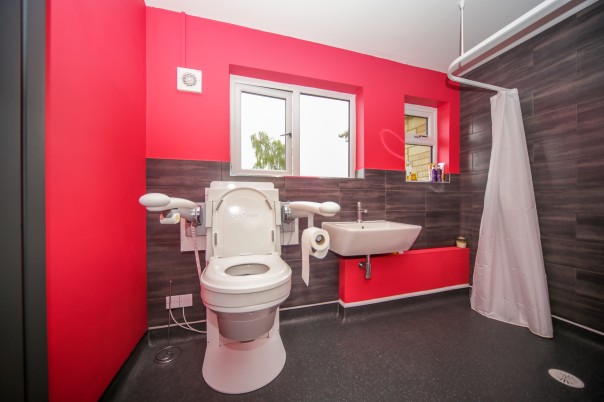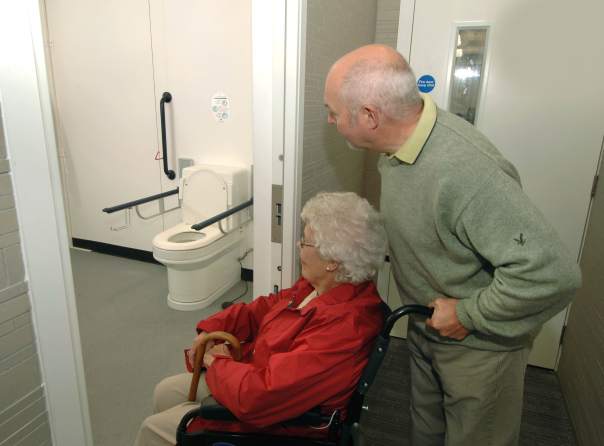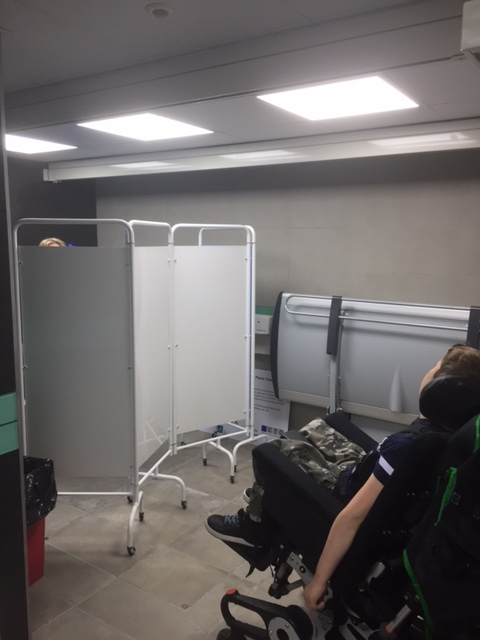It’s reasonable, isn’t it, when you’re doing the weekly shop, out for a meal, that you can go to the toilet, ‘ on site’ if you need?
Yet for up to 14million people*, it’s not something they can take for granted. Closomat, Britain’s leader in away from home assisted accessible toilets, reports that one campaigner for these facilities has recently been told that, as there are suitable conveniences within a mile of her local supermarket, it won’t put in those special toilets. So potentially, she has to abandon her shop and leave the store should her son need intimate care attention.
Under the Equality Act (which replaced the Disability Discrimination Act), service providers are required to make reasonable changes- including to the built environment- where a disabled customer or potential customer would otherwise be at a substantial disadvantage. Is the situation above acceptable, or does it leave that family at a substantial disadvantage…?
That family above is not alone. Estimates indicate conventional wheelchair-accessible (Document M) toilets fail to meet the requirements of up to 14 million people(*). They may need help to get on, off, clean themselves. They may need to be lifted. They may need changing. That is all equipment provided by assisted accessible toilets, be they Changing Places or their counterpart Space to Change toilets.

The Changing Places campaign states 230,000 people in the UK need these toilets. That figure is based on the number of people who need the support of up to two carers, and need a hoist, and need a changing table, and need a privacy screen.
There are millions of others who need only one or two of those extra facilities and fixtures – for example, a third of wheelchair users rely on a carer to propel them; if you are a carer, the chances are you struggle to lift the person you care for from the wheelchair onto the toilet- you need a hoist. According to the Bladder & Bowel Foundation, more people in Britain suffer from faecal incontinence than suffer from asthma or diabetes, so may need changing facilities. And what about the carer of a disabled person? Are they supposed to abandon them outside the loo when they need to ’go’?
Changing Places & Space to Change
Under current Building Regulations, a Changing Places is desirable in buildings to which numbers of the pubic have access. It refers to the British Standard BS8300 for the definition, which, at its core, is:
- A toilet facility in addition to a conventional wheelchair-accessible toilet
- 3m x 4m with a ceiling height of 2.4m
- ceiling track hoist
- adult-sized changing bench
- privacy screen
Campaigners for Changing Places have found that many venues say they cannot install the facility because of the required space, and/or the cost of all the additional equipment. Thus, with the support of Closomat, the Space to Change campaign was born.
Space to Change bridges the gap between conventional wheelchair accessible toilets and the supplementary Changing Places. Space to Change builds on the Regulatory requirement that says even when only one WC is provided, it should be a wheelchair-accessible toilet. Space to Change asks that just 5m2 is added to that standard wheelchair-accessible facility (to give a total 7.5m2), to enable inclusion of an adult-sized changing bench and hoist. Already it is being positively received from retail brands and leading supermarkets, as a viable solution to their ability to accommodate specific customer needs without majorly altering existing outlets.
Size Matters
There are specific reasons why those dimensions are chosen. There is a trend towards conceding on the dimensions to ensure the facility is provided, but reduce it too far, and the room becomes unuseable!
Campaigners say anything less than 7.5m2 means that whilst they can get themselves and their loved one into the room, it becomes almost impossible to manoeuvre the wheelchair and safely execute a transfer to the WC or changing bench.
There have also been instances where the ceiling is lower. That has meant there isn’t the necessary clearance to use the hoist to lift the person from the wheelchair onto the toilet or bench.
It is therefore sensible to utilise the skillset of away from home toilet providers who can properly assess the potential space, advise on considerations (down to whether the structure is strong enough to load bear the hoist and bench), and ensure the completed installation and compliant in every way- and useable!
Shout About It!
So often, venues install a Changing Places or Space to Change and leave it at that. Then they wonder why it’s not used.
Closomat has developed a package of measures to help venues optimise the facility. In addition to officially registering the toilet, it can provide in-depth staff training, and various signs to help users maximise the facility’s potential.
Closomat also suggests it’s sensible to do much more than just put a sign on the door. It proposes:
– Extend signage throughout your premises- perhaps even put something in the window
– Promote it on your website
– Promote it on your social media
– Tell your local media
– Promote it to local wheelchair user groups and other local disability charities- maybe even run special events, discounts for potential users…
“If people don’t know about it, how can they use it?” asks Ian Tomlinson, Closomat director responsible for away from home toileting. “Because of lack of appropriate toilets, people who need these facilities either cut their trip short, only go somewhere they know they can ‘go’, or don’t go out at all. The more providers publicise the facilities, the more they will be used.”
Toilet provision pays
Regardless of the social/ corporate responsibility aspects of providing such facilities, there are financial benefits too.
Disabled people spend up to £249billion a year. Parties with a disabled member spend £12.4billion a year on travel and tourism- a figure that would only increase if they knew they could expect appropriate toilet facilities.
Provision of Closomat Changing Places and Space to Change is proven to pay. Alton Towers opened its Changing Places and Space to Change at the start of the 2017 season, and is seeing the facilities used on average 20 times/day, every day.
Cornwall Services on the busy A30 trunk road opened its facility a year ago, and is seeing it used on average 10 times/ day, with visitors reporting stopping there specifically because of the toilet.
“We are so pleased with the positive response we continue to have: one of the best projects I think I’ve been involved with in terms of the effect it has directly had on guests,” says Justine Locker, Resort Excellence Manager at Alton Towers.
Clos-o-Mat is the only UK company with the in-house capability to advice on, help design, supply, install, commission and then service & maintain all the equipment required to create either a Changing Places or Space to Change facility. Its website www.clos-o-mat.com is now the ‘go to’ resource for away from home toilet provision guidance; it contains typical layouts, details of regulatory and best practice compliance, CAD blocks, videos, and white papers.
ENDS
(*)Potential users of a wheelchair-accessible toilet with space, bench and hoist include:
– 1.5m wheelchair users
– 6.5 million people who have either bladder or bowel incontinence
-1.5million people with a learning disability
– 1.2million people living with stroke
– 62,000 amputees
– 30,000 people with cerebral palsy
– 13,000 people with acquired brain injuries
– 8,500 people with multiple sclerosis
– 100,000 [people with muscular dystrophies
– 5000 people with motor neurone disease
– 8,000 people with spina bifida
– 40,000 people with spinal injuries
– 120,000 people with a stoma
– 3.8million adults morbidly obese
– 0.8million disabled children
– 8.7million people with osteoarthritis
– 400,000 people with rheumatoid arthritis
 Interestingly, there is a growing awareness of intimate care technology, and the impact of the ‘wellness’ features available. It’s something we’ve been delivering for almost 60 years, in our shower toilets.
Interestingly, there is a growing awareness of intimate care technology, and the impact of the ‘wellness’ features available. It’s something we’ve been delivering for almost 60 years, in our shower toilets.

 So come on developers: lead the way whatever sector you operate in, just slightly adjust your designs and build processes, and enable millions of people to get on with living life.
So come on developers: lead the way whatever sector you operate in, just slightly adjust your designs and build processes, and enable millions of people to get on with living life.


 One of Closomat’s Aerolet toilet lifters could enable a person to get on and off the WC without help. If in an individual’s home, when they no longer needed it, it could be moved to a different address to deliver the same benefit to another. So even though the capital cost has been recouped, the equipment is still delivering benefit- in effect free of charge! There are further benefits too. By empowering the recipient to undertake something so intimate without help, you enhance their feeling of independence, empowerment, of being in control. All have significant psychological benefits, improving the person’s mental health and thus potentially reducing the need for medical intervention. Such equipment can help them stay in their own home, reducing their need for care support, so you ease the strain on already stretched homecare resources. It alleviates their need for admission to a residential care home, so you ease the strain on the lack of available beds.
One of Closomat’s Aerolet toilet lifters could enable a person to get on and off the WC without help. If in an individual’s home, when they no longer needed it, it could be moved to a different address to deliver the same benefit to another. So even though the capital cost has been recouped, the equipment is still delivering benefit- in effect free of charge! There are further benefits too. By empowering the recipient to undertake something so intimate without help, you enhance their feeling of independence, empowerment, of being in control. All have significant psychological benefits, improving the person’s mental health and thus potentially reducing the need for medical intervention. Such equipment can help them stay in their own home, reducing their need for care support, so you ease the strain on already stretched homecare resources. It alleviates their need for admission to a residential care home, so you ease the strain on the lack of available beds.


